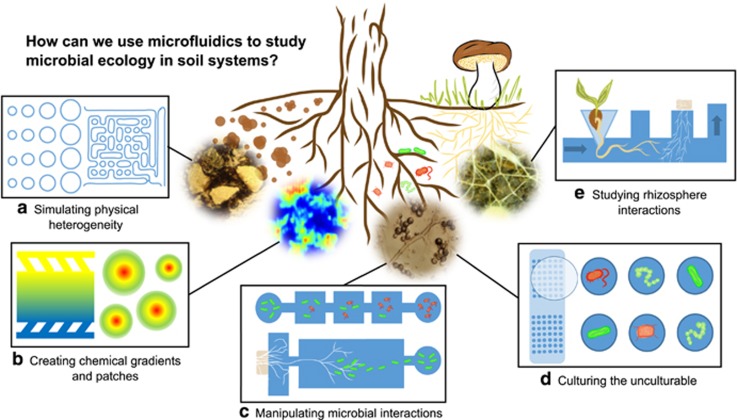Figure 2.
Five aspects of how microfluidics can be used to mimic the soil-environment and study microbial behavior in a small-structured environment. (a) Simulating physical heterogeneity. Pillars and walls of different sizes and shapes can be used to simulate differences in soil structure and porosity to study how variation in physical heterogeneity affects, for example, microbial establishment, behavior (Held et al., 2010; Deng et al., 2015), and feedback interactions with their environment. (b) Creating chemical gradients and patches. Chemical gradients or plume-like injections can be created inside the chips to mimic spatial heterogeneity of nutrients or other soluble compounds and study, for example, chemotaxis (Stocker et al., 2008). (c) Manipulating microbial interactions. Arenas for the study of microbial physiology, behavior and interactions can be fabricated, allowing minute control over when and where microbes enter the system, with the possibility to restrict encounters to few individual cells or hyphae (Stanley et al., 2014; Hol et al., 2016). (d) Culturing the unculturable. With the development of the Ichip (Nichols et al., 2010), new possibilities have opened up for culturing soil bacteria that have not previously been possible in solid medium cultures. The main design factor thought to facilitate this is the micro-confinement of individual cells in diffusion chambers sealed off with membranes, still allowing for metabolic transfer to and from the surrounding environment. This strongly expands the species pool for laboratory studies, and facilitates identification of their special requirements for pure culture isolation. (e) Studying rhizosphere interactions. Plant roots can be grown from seeds, for example, through pipette tips, into channels of microfluidic devices (Grossmann et al., 2011), permitting close monitoring of root morphology, and giving us the ability to control nutrient supply as well as microbial exposure within the root system. This will open up possibilities to study, for example, the colonization success and succession of root symbiosis such as those involving rhizobia and mycorrhizas, or monitoring of pathogens under differentiated nutrient conditions.

